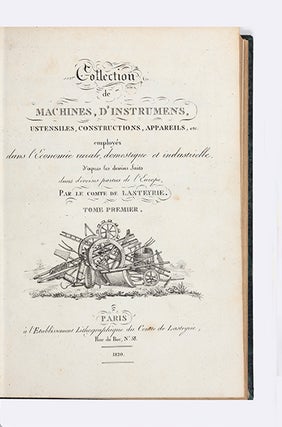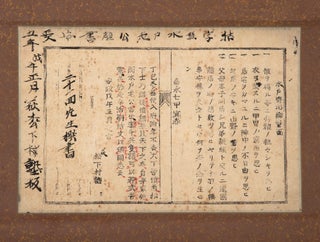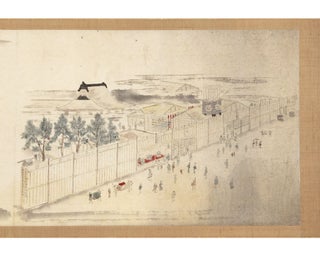A Rare & Early Jesuit Imprint in Beijing;
The First Printed Statement in China that the Earth is Round
Biao du shuo 表度說 [Explanation of the Gnomon]
Numerous woodcuts (some full-page & some half-page) in the text. 6, 3, 40 folding leaves. 8vo, old, possibly orig. wrappers (with several repairs, one of which touches but does not obscure the text), orig. block-printed label on upper cover, new stitching. [Beijing: 2nd Preface dated 1614].
First edition, and very rare, of this work on the gnomon, one of the first astronomical measuring instruments, and its uses in astronomy and surveying. This work is important in the history of astronomy as it states here for the first time in China the doctrine that “the earth is spherical” (di ben yuanti 地本圓體). Ursis is also the first to state in China, in the present work, that the earth is divided into spaces separated by meridians and parallels. He uses geometrical analysis of planetary motions and the Euclidean geometry necessary for applying it to gnomonics, stereographic projections of the astrolabe, and in surveying.
The beginning of the text discusses the five questions regarding latitude. In one of the woodcuts, the earth is depicted as casting a shadow as the sun revolves around it. In another of the woodcuts, Ursis shows two boats taking opposite routes from the Atlantic Ocean (“Da Xiyang”) to the Indian Ocean (“Xiao Xiyang”) with the endpoint of their journeys shown at the bottom of the earth. Europe, Asia, and Africa are depicted on a spherical globe, rather than as a square image. In the following woodcut, we see the same two ships leaving the Atlantic but now North and South America are shown. This is the first depiction of the Americas in a Chinese-printed book. The fact that ships could leave the same point, going in opposite directions, and yet arrive at the same destination demonstrated the earth is round.
The remainder of the book is concerned with the height of the sun, the length of shadow caused by a moving sun, geographical matters, the summer and winter solstice, and surveying problems using the gnomon.
One of the two prefaces was written by Xiong Mingyu (1579-1649), the most senior member of the Fang School. He was one of the first of the late Ming scholars to accept the Jesuits’ notion of the shape of the earth. He states in his preface that the Chinese already had had the same concept of the spherical globe in the time of the Yellow Emperor but social disruptions and the destruction of many books within China caused this knowledge to be lost.
Sabatino de Ursis (1575-1620), a member of a prominent family in Naples, arrived in Peking in 1607 in order to help Matteo Ricci in his scientific work. He also worked together with Xu Guangqi and Ricci on the translation of Euclid’s Elements into Chinese. Following the death of Ricci in 1610, Ursis became the principal Jesuit astronomer in China. Ursis was involved in the reform of the Chinese calendar (based on his prediction of a solar eclipse on 15 December 1610 which the Chinese had not anticipated), translated the hydraulics portions of Ramelli’s book into Chinese (1612), and wrote a work on the armillary sphere (1611). These were later gathered and published in Peking in 1629 in a multi-volume encyclopedia of western astronomical science. Ursis’s Chinese name was Xiong Sanba 熊三拔, where Xiong, literally “bear,” translated Latin Ursis (from Ursus, “bear”), and Sanba was short for “Sabatino.”
This book was “translated orally” (kouyi 口譯) by Ursis into Chinese and written down in literary style by Zhou Ziyu 周子愚 and Zhuo Erkang 卓爾康 (1570-1644). Zhuo is also known as a scholar of the Yijing 易經 [Change Classic]. Zhou was later included in Ruan Yuan’s influential Chouren zhuan 疇人傳 [Biographies of Calendrical Experts] from 1799. The text of Explanation of the Gnomon itself was included in the Qianlong emperor’s voluminous imperial manuscript library Siku quanshu 四庫全書 [Complete Writings of the Four Repositories], albeit without the Prefaces seen in our copy. The editors of Siku quanshu commended the work for the “quick method” (jiefa 捷法) that it presented, which allowed for easy use of the gnomon. They further noted that the book was “replete with illustrations furnished with legends, providing reliable proof.”
Fine copy and extremely rare.
❧ Cordier, L’Imprimerie Sino-Européene en Chine, 315-2.
Needham, Science and Civilisation in China, Vol. 3, pp. 437-46.
Qiong Zhang, Making the New World their Own: Chinese Encounters with Jesuit Science in the Age of Discovery (2015), pp. 167-78.
Price: $75,000.00
Item ID: 5271

![Item ID: 5271 Biao du shuo 表度說 [Explanation of the Gnomon]. Sabatino de URSIS, Ziyu 周子愚, ZHOU, ZHUO Erkang 卓爾康, Xiong Sanba 熊三拔.](https://jonathanahill.cdn.bibliopolis.com/pictures/5271.jpg?width=768&height=1000&fit=bounds&auto=webp&v=1475847348)
![Biao du shuo 表度說 [Explanation of the Gnomon]](https://jonathanahill.cdn.bibliopolis.com/pictures/5271_2.jpg?width=320&height=427&fit=bounds&auto=webp&v=1475847348)
![Biao du shuo 表度說 [Explanation of the Gnomon]](https://jonathanahill.cdn.bibliopolis.com/pictures/5271_3.jpg?width=320&height=427&fit=bounds&auto=webp&v=1475847348)
![Biao du shuo 表度說 [Explanation of the Gnomon]](https://jonathanahill.cdn.bibliopolis.com/pictures/5271_4.jpg?width=320&height=427&fit=bounds&auto=webp&v=1475847348)
![Biao du shuo 表度說 [Explanation of the Gnomon]](https://jonathanahill.cdn.bibliopolis.com/pictures/5271_5.jpg?width=320&height=427&fit=bounds&auto=webp&v=1475847348)



